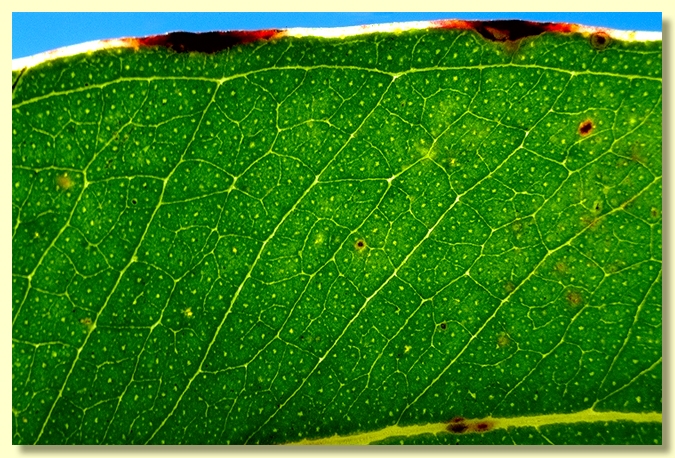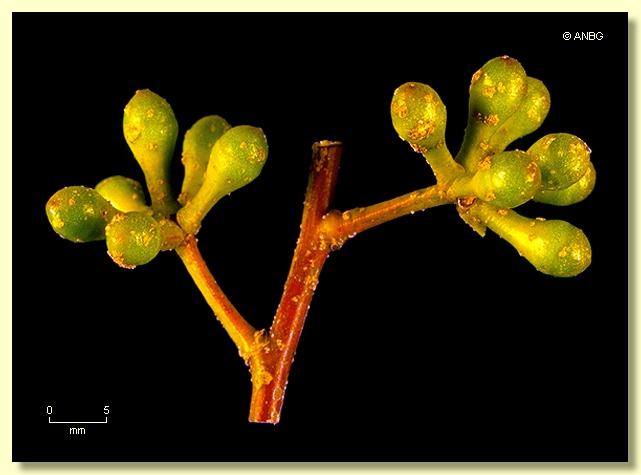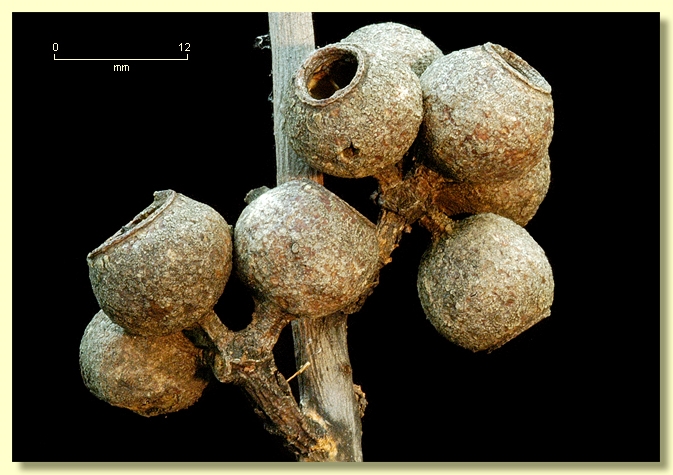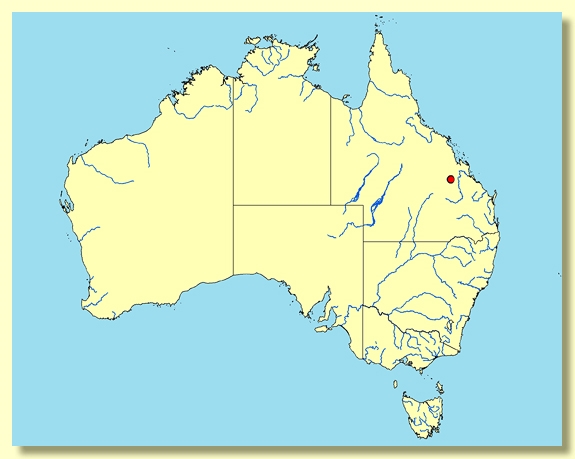Euclid - Online edition
Eucalyptus sphaerocarpa
Eucalyptus | Eucalyptus | Cineraceae | Sphaerocarpae
Tree to 45 m tall. Forming a lignotuber.
Bark rough over trunk and branches, moderately long-fibrous and becoming somewhat compact and shallowly fissured, grey or grey-brown to yellow-brown.
Juvenile growth (coppice or field seedlings to 50 cm): stem square in cross-section, smooth; juvenile leaves shortly petiolate, alternate, elliptic-lanceolate, 9–19 cm long, 2.5–6 cm wide, bases rounded to tapering, ± discolorous, dull, grey-green (non-glaucous).
Adult leaves alternate, petiole 1–3.7 cm long; blade lanceolate to falcate, (6.5)7.5–15 cm long, 1.2–3.5 cm wide, base tapering to petiole, margin entire, apex pointed (a drip-tip), concolorous when fresh bud may dry pinkish on underside, glossy, green to grey-green (crown blue-green viewed from a distance), side-veins at about 45° to midrib, sparsely to moderately reticulate, intramarginal vein present, oil glands small, island.
Inflorescence axillary unbranched, peduncles flattened, 1–1.8 cm long, buds in umbels of 7, 9 or 11, pedicellate (pedicels 0.3–0.6 cm long). Mature buds ovoid, 0.7–0.9 cm long, 0.4–0.5 cm wide, operculum scar absent, operculum conical, stamens irregularly flexed, anthers reniform to cordate, versatile, dorsifixed, dehiscing by confluent slits, style long, stigma blunt or tapered, locules 3, the placentae each with 2 vertical ovule rows. Flowers white.
Fruit on pedicels 0.2–0.5 cm long, truncate-globose, 0.9–1.2 cm long, 1–1.3 cm wide, disc descending vertically or obliquely, valves 3, enclosed.
Seeds dark brown, 2–3.5 mm long, pyramidal or obliquely pyramidal, dorsal surface smooth, hilum terminal.
Cultivated seedlings (measured at ca node 10): cotyledons reniform; stems square in cross-section; leaves sessile, opposite, ± amplexicaul and elliptic for 4–8 nodes, then becoming shortly petiolate, then alternate after 8–12 nodes, lanceolate, 6.5–16 cm long, 2.7–5 cm wide, base at node 10 rounded or tapering, margin entire, apex pointed, discolorous, dull, grey to grey-green (non-glaucous), glabrous.
Flowering has been recorded in September.
A tall forest tree endemic to the Blackdown Tableland area west of Rockhampton, Queensland, where it occurs on grey sand or sandy loam on the gently undulating plateau and upper levels of valleys draining the tableland. Eucalyptus sphaerocarpa is distinguished by its firm stringy-type bark throughout, bluish crown of leaves with venation sparsely to moderately reticulate, flattened peduncles, umbels of 7–11 ovoid buds, globose fruit 1–1.3 cm diameter and glabrous juvenile leaves.
Within its restricted natural distribution there are only three other species with stringy-type bark, E. baileyana, which differs in having discolorous leaves, buds only in clusters of seven, when in flower the stamens obviously arranged in four groups, squat globose-urceolate fruit to 1.7 cm diameter and with a thin rim and "stellate-hairy" juvenile leaves; E. acmenoides, which also has discolorous leaves, ovoid-fusiform buds in clusters of 11–15, hemispherical-globose to barrel-shaped fruit to 0.9 cm diameter and glabrous juvenile leaves; and E. cameronii, a true stringybark species with only slightly discolorous or concolorous leaves, small more or less sessile fusiform buds in clusters of 9–15, fruit more or less globose and 0.4–0.8 cm diameter, and "stellate-hairy" juvenile leaves.
In the classification of Brooker (2000) Eucalyptus sphaerocarpa belongs to Eucalyptus subgenus Eucalyptus section Cineracea, because the buds have a single operculum, the anthers are reniform and dehisce by confluent slits, ovules are in two rows, the seeds are more or less pyramidal and seedling and juvenile leaves are bluish to greyish, sessile and opposite at first then becoming petiolate and alternate. The seedling leaves lack the "stellate hairs" found in the true stringybarks.
Eucalyptus sphaerocarpa : Latin sphaera -, sphere and - carpos, fruit, referring to the shape of the fruits.













